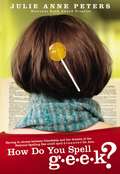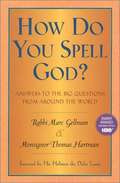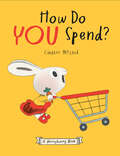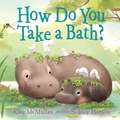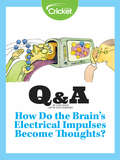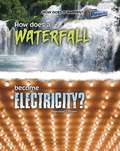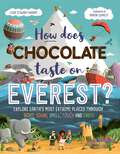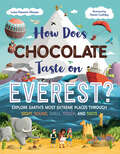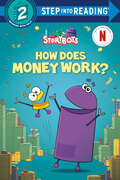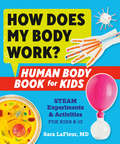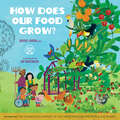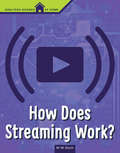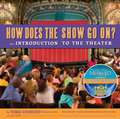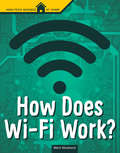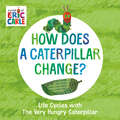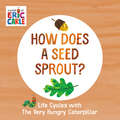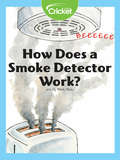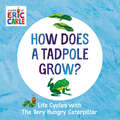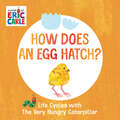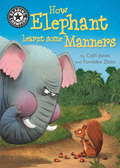- Table View
- List View
How Do You Spell Geek?
by Julie Anne PetersThe relationship between best friends Kimberly and Ann is put to the test when Ann takes a geeky new student under her wing and encourages her to compete against front-runner Kimberly in the spelling bee.
How Do You Spell God?: Answers to the Big Questions from Around the World
by Marc Gellman Thomas HartmanPeople don't want to learn about religions just because there are religions out there. People want to learn about religions because they know that religions have great answers to the big questions. Award-winning authors Rabbi Marc Gellman and Monsignor Thomas Hartman have produced a unique way of looking at the world's religions. Instead of isolating each religion in its own separate chapter, this book unites the religions by showing how each of them answers these universal questions: How should we live? What happens to us after we die? Why does bad stuff happen to good folks? How can we talk to God? With a refreshing combination of humor and sensitivity, a rabbi and priest show us how Judaism, Christianity, Islam, Buddhism, Hinduism, and the other great religions teach us to live. This wise and often thoughtprovoking book shows us that each religion has its own wisdom and its own wonderful stories. It also explains who works for God, why the world's religions are so different, and why some days of the year have become holy. How Do You Spell God? helps us appreciate religions from all over the world. It will also help us better understand our planet, our families, and ourselves.
How Do You Spend? A Moneybunny Book (A Moneybunny Book)
by Cinders McLeodCelebrate the many different ways a little bunny can spend her savings, and learn about opposites too!Bun has been saving her carrots, and now it&’s time to spend some—but HOW will she spend them? Well, she could spend fast and buy a lot of things all at once, or she could take her time and spend slowly on something unique. She could buy something ordinary like a toothbrush, or something exciting like a mini sports car. Then there are things to buy for herself and things to buy for others, as well as things she needs and some that she wants. There are so many options, and little bunnies will have a ball considering them all!
How Do You Take a Bath?
by Kate McMullanPerfect for fans of Five Little Monkeys Jump in the Bath, this fun and educational picture book brings together adorable baby animals and bathtime.How do YOU take a bath? Does your mama comb your fur?Do you shake off all your dirt?Do you splash and flap and quack?Do the birdies peck your back?No!Follow elephants, pigs, monkeys, hippos, and more in this charming rhyming picture book from veteran author Kate McMullan. How does a pig take a bath? It sinks in the mud! What about a chicken? It thrashes about in dust! And a cat? Why, it licks itself clean, of course! Sydney Hanson's adorable illustrations toggle neatly between animals in nature grooming themselves and humorous depictions of children attempting the animals' bathing tactics. By the end of the book, the child finally makes his way to the bathtub, no mud baths or lick baths about it!
How Do the Brain's Electrical Impulses Become Thoughts?
by Lizzie WadeHow do brain impulses translate into a state of mind? This Q & A explores the science of the brain and gives an insight into feelings and abilities.
How Does A Waterfall Become Electricity? (How Does It Happen)
by Robert SneddenWhat is the world's tallest waterfall?What is the world's tallest waterfall? How do dams help generate water power? What happens when a waterwheel spins? This series explores the causes and effects that shape our world. From the underwater volcanoes that sprout into islands, to the rushing waterfalls that spark electric currents, this series demonstrates how both natural and man-made phenomena occur.
How Does Chocolate Taste on Everest?: Explore Earth's Most Extreme Places Through Sight, Sound, Smell, Touch and Taste
by Leisa Stewart-SharpeDon't get too comfortable. This isn't the type of book you can snuggle up with under the covers. Not even close! You're off on the expedition of a lifetime to experience the sights, sounds, smells, feelings and tastes of the world's most extreme places. Have you ever wondered what the buzz of the rainforest sounds like on a trek through the Amazon? Or how it would feel to experience the biting cold as you voyage across Antarctica? Or how about how chocolate would taste on Mount Everest? From every heart-bursting sight to tummy-lurching bite, this is a truly immersive round-the-world adventure, where YOU are the explorer.
How Does Chocolate Taste on Everest?: Explore Earth's Most Extreme Places Through Sight, Sound, Smell, Touch, and Taste
by Leisa Stewart-SharpeAn immersive round-the-world adventure, where YOU are the explorer experiencing the most extreme places on earth and doing it all through your five senses.Have you ever wondered what the buzz of the rain forest sounds like on a trek through the Amazon? Or how it feels to experience the biting cold as you voyage across Antarctica? Or how chocolate tastes on Mount Everest? From every heart-bursting sight to tummy-lurching smell, you will experience them all–and do so without having to leave the comforts of your couch.This funny and fast-paced interactive thrill ride that young adventure-seekers are sure to enjoy is chock-full of facts, history, and survival tips peppered on every page.
How Does It Feel to Be Old?
by Norma FarberA very old grandmother tells her young granddaughter the positives and negatives of being old. The telling is in rhyme. Descriptions of illustrations included. A short book, very comforting about old age.
How Does Money Work? (Step into Reading)
by Scott EmmonsThe robots from Netflix's StoryBots Answer Time star in an all-new Step 2 Step into Reading leveled reader!Bing wants to know what money is and why we use it. His questions lead him from a bank to a tour of a successful lemonade stand. What he learns will fascinate children ages 4 to 6 who love Netflix's educational show.Step 2 Readers use basic vocabulary and short sentences to tell simple stories. For children who recognize familiar words and can sound out new words with help.
How Does My Body Work? Human Body Book for Kids: STEAM Experiments and Activities for Kids 8-12
by Sara LaFleurHow does your body work? This fun human anatomy book helps kids 8-12 answer that question through awesome, hands-on STEAM/STEM experiments and activities.Entertaining and interactive, The Human Body Book for Kids shows curious kids how their body systems help them move, breathe, fight infections, and keep them alive!Filled with fascinating information about human anatomy, this exciting science book features: • More than 40 STEAM experiments and activities that help kids learn about their amazing bodies. • Full-color illustrations and photographs that highlight the cells, tissues, organs and body systems as well as explain the steps and outcomes of the experiments. • A doctor author, an MD who works with both children and adults and is an expert on the human body inside and out. • Weird and wonderful facts about the human body: Did you know that you&’re about 1 cm taller in the morning than the evening? That a baby is born with 300 bones but has only 206 by the time they&’re an adult? That some children are born with an extra set of ribs surrounding the lungs called &“gorilla ribs&”? • Learning and fun together: Kids will create models, eat experiments, and show off their STEAM skills to family and friends. Endorsed by the co-founder of Apple&’s Siri, this educational book is a great resource for answering kids&’ questions about how their bodies work.
How Does Our Food Grow
by Brooke JordenFruits and vegetables all taste great, but how did they end up on your plate? The fresh and colorful foods you know came from farms—that&’s where they grow! Some grow underground and some hang from trees. Can you find them all? Let&’s look and see! Every fruit, vegetable, grain, and legume has its own story: Where do they grow? How do they taste? And how do they impact our bodies and the world around us? In cooperation with Kitchen Connection, an organization committed to improving our food system through education, this colorful picture book introduces readers to the concepts of biodiversity, reducing food waste, and proper growing conditions for different crops in simple, accessible language. With cool facts and challenges throughout, fun rhyming verse, and charming illustrations, How Does Our Food Grow? tells the stories of more than a dozen of your favorite fresh foods. Knowing that our food choices make a difference in our health and the health of our planet empowers us to choose wisely. The more we know, the better we grow.
How Does Santa Go Down the Chimney?
by Mac BarnettWhen Santa arrives at a child’s house on Christmas Eve, does he go down the chimney feetfirst or headfirst? What if he gets stuck? What if there’s no chimney? Maybe he slides under the door, as thin as a piece of paper? Or is it possible he pours himself through the faucet? What happens once he’s inside? Whether it’s shape-shifting or impromptu laundry use, Mac Barnett’s iconic talent for earnest deadpan humor and Jon Klassen’s irresistibly funny art honor the timeless question with answers both ridiculous and plausible, mounting in hilarity as the night continues. Channeling a child’s fanciful explanations (and begging for further speculation), this latest collaboration by a New York Times best-selling team will find a secure spot among family holiday traditions.
How Does Streaming Work? (High Tech Science at Home)
by M. M. EbochWhether you're watching a movie, bingeing on a classic TV show, or listening to your favorite song, you're probably streaming it. Videotapes, DVDs, and CDs are mostly just memories now. Streaming puts a world of options at your fingertips when you’re at home and, with a smartphone or tablet, when you're on the go. Find out how streaming was invented, how it works, and what the future might hold for this part of a high-tech life.
How Does The Show Go On?: An Introduction To The Theater (A Disney Theatrical Souvenir Book)
by Jeff Kurtti Thomas SchumacherFilled with detailed explanations, captivating illustrations, and entertaining trivia, this clearly written, lively, and uniquely-designed book is a first-of-its-kind introduction to the world of the Theatre, from the box office to backstage, and beyond. From one side of the book, the reader enters via the front door, where the people and activities of the “front of house” can be examined. From the book’s other side, the reader enters the “Stage Door,” where the behind-the-scenes world of the “Back of house” is revealed. In exploring this visually-inviting “theatre of the mind,” readers encounter the people, places, occupations, and equipment of the theatre world, and have the opportunity to investigate them all. From the box office and the Usher Staff to the Dressing Rooms and the Backstage doorman, the reader may wander at will within this one-of-a-kind world, discovering the wonders of theatre all along the way.
How Does Wi-Fi Work? (High Tech Science at Home)
by Mark WeaklandYou probably use Wi-Fi all the time to connect to the internet through your laptop, tablet, or phone. It's easy. Wi-Fi hotspots surround you as you go through your day - from school to a pizza place or coffee shop and then back home. Not so long ago, the internet wasn't as accessible. Find out how Wi-Fi works, how it became commonplace, and what it might do for you in the future.
How Does a Caterpillar Change?: Life Cycles with The Very Hungry Caterpillar (The World of Eric Carle)
by Eric CarleLearn how a caterpillar turns into a butterfly with the help of The Very Hungry Caterpillar!In this nonfiction story, young readers can explore the transformation of a caterpillar into a butterfly. The miracles of nature come to life in this early-learning series centered around life cycles, featuring simple text and Eric Carle's classic illustrations!
How Does a Czar Eat Potatoes?
by Janosch Anne K. RoseRose cleverly translates Janosch's book, in which the czar drinks tea from a sugar-loaf while the peasant father only dreams of sugar. Children will appreciate the poetic style, while grown-ups will think: how true are these life contrasts. "And your father, how does he bathe? My father, bathe? In the summer when it's hot The river awaits him. In the winter when it's cold He waits for summer. And that's the way, that's the way My father bathes."
How Does a Seed Sprout?: Life Cycles with The Very Hungry Caterpillar (The World of Eric Carle)
by Eric CarleLearn how a seed becomes a tree with Eric Carle's classic artwork and The Very Hungry Caterpillar!In this nonfiction story, young readers explore the transformation of a seed into a tree. The miracles of nature come to life in this early-learning series centered around life cycles, featuring simple text and Eric Carle's classic illustrations!
How Does a Smoke Detector Work?
by Liz HuyckEver wonder why a smoke alarm goes off? A battery, siren, and metal can work together to detect smoke and sound the alarm when catching a whiff of smoke.
How Does a Tadpole Grow?: Life Cycles with The Very Hungry Caterpillar (The World of Eric Carle)
by Eric CarleLearn how a tadpole becomes a frog with Eric Carle's classic artwork and The Very Hungry Caterpillar!In this nonfiction story, young readers explore the transformation of a tadpole into a frog. The miracles of nature come to life in this early-learning series centered around life cycles, featuring simple text and Eric Carle's classic illustrations!
How Does a Tree Help? (Into Reading, Level B)
by David Bauer<p>NIMAC-sourced textbook <p>All kinds of animals make their homes in trees. Children do, too!</p>
How Does an Egg Hatch?: Life Cycles with The Very Hungry Caterpillar (The World of Eric Carle)
by Eric CarleLearn how an egg becomes a baby chick with Eric Carle's classic artwork!In this nonfiction story, young readers explore the transformation of an egg into a chick. The miracles of nature come to life in this early-learning series centered around life cycles, featuring simple text and Eric Carle's classic illustrations!
How Dumb Can You Get (Junior High #4)
by Kate KenyonCAN NORA REALLY FIX ANYTHING? From the class dunce in shop, Nora has become the class star. Now that she understands mechanics, she can fix anything, except the attitude of her handsome shop partner, Brad. Did he really only like her when she couldn't tell a nut from a bolt? Spacey Tracy advises Nora to be dumb again to regain Brad's interest. Nora's best friend, Jen, is disgusted by the advice, but Nora is not so sure. Then on a class trip, an emergency puts Nora to the test: Is it really smarter to play dumb?
How Elephant Learnt Some Manners: Independent Reading 12 (Reading Champion #511)
by Cath JonesThis story is part of Reading Champion, a series carefully linked to book bands to encourage independent reading skills, developed with Dr Sue Bodman and Glen Franklin of UCL Institute of Education (IOE). This book is aimed at Independent Reading 12, for readers aged 7 years old and up, or in the second half of Year 3.Elephant is the biggest and also thinks he's the best. He's always a bit rude to the other animals, until some clever squirrels teach him a lesson.Reading Champion offers independent reading books for children to practise and reinforce their developing reading skills.Fantastic, original stories are accompanied by engaging artwork and a reading activity. Each book has been carefully graded so that it can be matched to a child's reading ability, encouraging reading for pleasure.The Key Stage 2 Reading Champion Books are suggested for use as follows:Independent Reading 11: start of Year 3 or age 7+Independent Reading 12: end of Year 3 or age 7+Independent Reading 13: start of Year 4 or age 8+Independent Reading 14: end of Year 4 or age 8+Independent Reading 15: start of Year 5 or age 9+Independent Reading 16: end of Year 5 or age 9+Independent Reading 17: start of Year 6 or age 10+Independent Reading 18: end of Year 6 or age 10+
